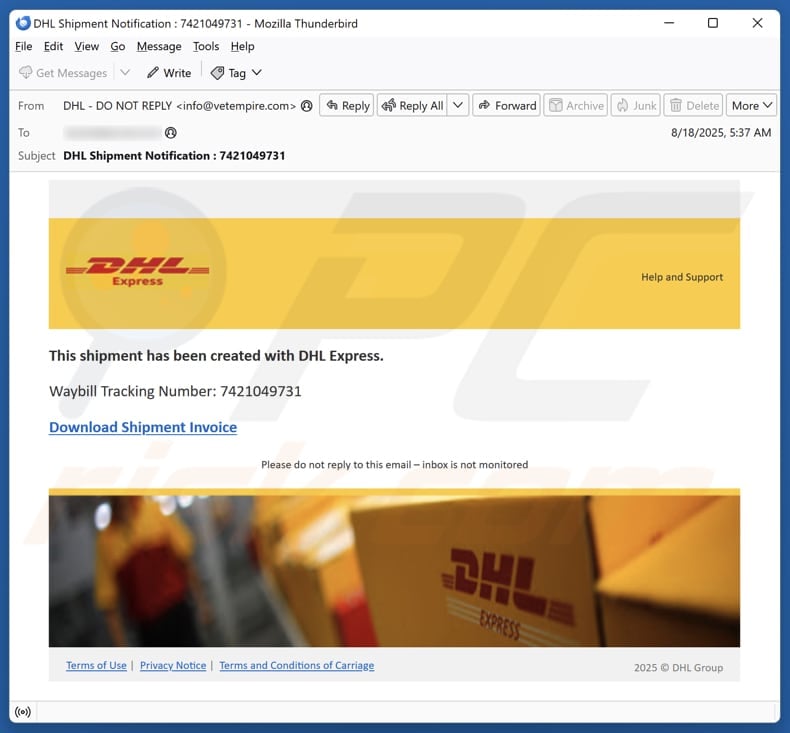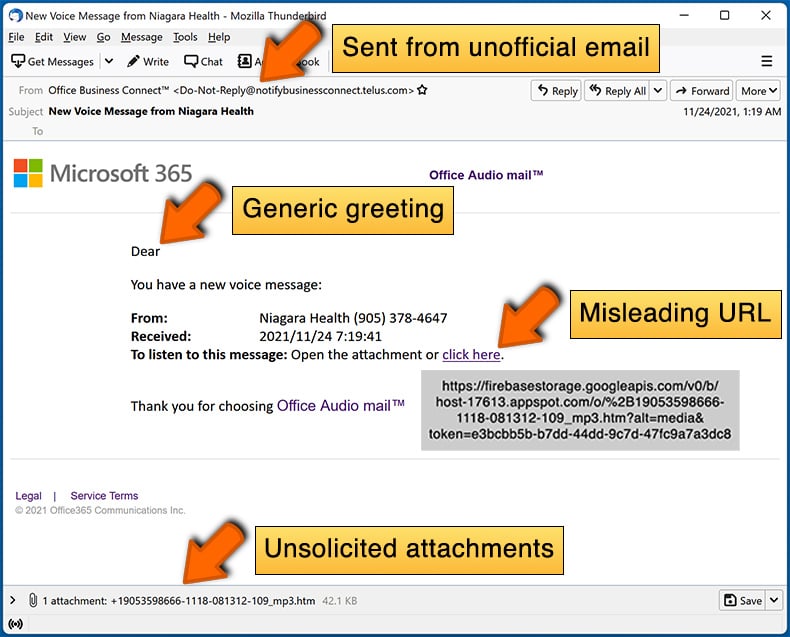How to identify scams like "Shipment Has Been Created With DHL Express"
Phishing/ScamAlso Known As: Shipment Has Been Created With DHL Express phishing email
Get free scan and check if your device is infected.
Remove it nowTo use full-featured product, you have to purchase a license for Combo Cleaner. Seven days free trial available. Combo Cleaner is owned and operated by RCS LT, the parent company of PCRisk.com.
What is "Shipment Has Been Created With DHL Express"?
We analyzed the email and determined it is a fake message pretending to be from DHL. Its goal is to trick recipients into clicking the link and providing personal information. This type of scam is called phishing, and recognizing (and ignoring) such emails prevents potential risks.

More about the "Shipment Has Been Created With DHL Express" scam email
The scam email claims to be a DHL shipment notification. It presents itself as coming from DHL Express Help and Support and states that a shipment has been created (it also includes a fake waybill tracking number). The message urges the recipient to download the shipment invoice.
The link provided in this email ("Download Shipment Invoice") is supposed to open a phishing site mimicking the DHL login page. During our inspection, the site was down. However, phishing sites in such emails are usually designed to extract login credentials from unsuspecting individuals.
Scammers can use stolen DHL login credentials to access personal delivery information or intercept packages by changing delivery addresses. They may also sell the credentials on the dark web. If the victim uses the same password on multiple accounts, scammers could gain access to email, banking, or other online services.
This could lead to identity theft, monetary loss, and other issues. Therefore, it is important not to open links in phishing emails and never respond to suspicious messages.
| Name | Shipment Has Been Created With DHL Express |
| Threat Type | Phishing, Scam, Social Engineering, Fraud |
| Fake Claim | A shipment has been created with DHL Express |
| Disguise | Notification from DHL |
| Symptoms | Unauthorized online purchases, changed online account passwords, identity theft, illegal access of the computer. |
| Distribution methods | Deceptive emails, rogue online pop-up ads, search engine poisoning techniques, misspelled domains. |
| Damage | Loss of sensitive private information, monetary loss, identity theft. |
| Malware Removal (Windows) |
To eliminate possible malware infections, scan your computer with legitimate antivirus software. Our security researchers recommend using Combo Cleaner. Download Combo CleanerTo use full-featured product, you have to purchase a license for Combo Cleaner. 7 days free trial available. Combo Cleaner is owned and operated by RCS LT, the parent company of PCRisk.com. |
Similar scam emails in general
Phishing emails are deceptive messages designed to steal personal information, such as credit card details or login credentials by tricking recipients into clicking links or opening attachments. Falling for them can lead to identity theft, financial loss, or unauthorized access to multiple accounts.
Sometimes, emails of this type can be used to deliver malware. Users should be cautious, verify senders, and avoid interacting with suspicious content (links or files in deceptive emails). Examples of similar scams are "Session Expired Email Scam", "Secure Your Cloudflare Account Email Scam", and "Account Validation Request Email Scam".
How do spam campaigns infect computers?
Threat actors distribute malware via email by attaching infected files. These attachments can include Word or Excel documents, PDFs, scripts, executable files (like .exe), or archives like ZIP and RAR. Interacting with these files, such as opening them or enabling macros, can result in malware infecting the system.
Malware can also be delivered through links. Clicking these links may direct users to websites that either automatically download malware or use deceptive methods to convince users to manually download and execute malicious software.
How to avoid installation of malware?
Exercise caution with emails from unfamiliar or dubious senders, especially those containing unexpected attachments or suspicious links. Only obtain software and files from trustworthy sources, like official websites or app stores. Avoid pirated programs, cracking tools, or key generators.
Do not trust pop-ups, advertisements, or interactive content on unreliable websites, and never allow notifications from questionable sites. Ensure your operating system and applications are regularly updated, and use a reliable antivirus protection. If you have already opened malicious attachments, we recommend running a scan with Combo Cleaner Antivirus for Windows to automatically eliminate infiltrated malware.
Text presented in the "Shipment Has Been Created With DHL Express" email letter:
Subject: DHL Shipment Notification : 7421049731
DHL Express Help and Support
This shipment has been created with DHL Express.
Waybill Tracking Number: 7421049731
Download Shipment Invoice
Please do not reply to this email – inbox is not monitored
Footer Alt Text
Terms of Use | Privacy Notice | Terms and Conditions of Carriage 2025 © DHL Group
Instant automatic malware removal:
Manual threat removal might be a lengthy and complicated process that requires advanced IT skills. Combo Cleaner is a professional automatic malware removal tool that is recommended to get rid of malware. Download it by clicking the button below:
DOWNLOAD Combo CleanerBy downloading any software listed on this website you agree to our Privacy Policy and Terms of Use. To use full-featured product, you have to purchase a license for Combo Cleaner. 7 days free trial available. Combo Cleaner is owned and operated by RCS LT, the parent company of PCRisk.com.
Quick menu:
- What is Shipment Has Been Created With DHL Express phishing email?
- Types of malicious emails.
- How to spot a malicious email?
- What to do if you fell for an email scam?
Types of malicious emails:
![]() Phishing Emails
Phishing Emails
Most commonly, cybercriminals use deceptive emails to trick Internet users into giving away their sensitive private information, for example, login information for various online services, email accounts, or online banking information.
Such attacks are called phishing. In a phishing attack, cybercriminals usually send an email message with some popular service logo (for example, Microsoft, DHL, Amazon, Netflix), create urgency (wrong shipping address, expired password, etc.), and place a link which they hope their potential victims will click on.
After clicking the link presented in such email message, victims are redirected to a fake website that looks identical or extremely similar to the original one. Victims are then asked to enter their password, credit card details, or some other information that gets stolen by cybercriminals.
![]() Emails with Malicious Attachments
Emails with Malicious Attachments
Another popular attack vector is email spam with malicious attachments that infect users' computers with malware. Malicious attachments usually carry trojans that are capable of stealing passwords, banking information, and other sensitive information.
In such attacks, cybercriminals' main goal is to trick their potential victims into opening an infected email attachment. To achieve this goal, email messages usually talk about recently received invoices, faxes, or voice messages.
If a potential victim falls for the lure and opens the attachment, their computers get infected, and cybercriminals can collect a lot of sensitive information.
While it's a more complicated method to steal personal information (spam filters and antivirus programs usually detect such attempts), if successful, cybercriminals can get a much wider array of data and can collect information for a long period of time.
![]() Sextortion Emails
Sextortion Emails
This is a type of phishing. In this case, users receive an email claiming that a cybercriminal could access the webcam of the potential victim and has a video recording of one's masturbation.
To get rid of the video, victims are asked to pay a ransom (usually using Bitcoin or another cryptocurrency). Nevertheless, all of these claims are false - users who receive such emails should ignore and delete them.
How to spot a malicious email?
While cyber criminals try to make their lure emails look trustworthy, here are some things that you should look for when trying to spot a phishing email:
- Check the sender's ("from") email address: Hover your mouse over the "from" address and check if it's legitimate. For example, if you received an email from Microsoft, be sure to check if the email address is @microsoft.com and not something suspicious like @m1crosoft.com, @microsfot.com, @account-security-noreply.com, etc.
- Check for generic greetings: If the greeting in the email is "Dear user", "Dear @youremail.com", "Dear valued customer", this should raise suspiciousness. Most commonly, companies call you by your name. Lack of this information could signal a phishing attempt.
- Check the links in the email: Hover your mouse over the link presented in the email, if the link that appears seems suspicious, don't click it. For example, if you received an email from Microsoft and the link in the email shows that it will go to firebasestorage.googleapis.com/v0... you shouldn't trust it. It's best not to click any links in the emails but to visit the company website that sent you the email in the first place.
- Don't blindly trust email attachments: Most commonly, legitimate companies will ask you to log in to their website and to view any documents there; if you received an email with an attachment, it's a good idea to scan it with an antivirus application. Infected email attachments are a common attack vector used by cybercriminals.
To minimise the risk of opening phishing and malicious emails we recommend using Combo Cleaner Antivirus for Windows.
Example of a spam email:

What to do if you fell for an email scam?
- If you clicked on a link in a phishing email and entered your password - be sure to change your password as soon as possible. Usually, cybercriminals collect stolen credentials and then sell them to other groups that use them for malicious purposes. If you change your password in a timely manner, there's a chance that criminals won't have enough time to do any damage.
- If you entered your credit card information - contact your bank as soon as possible and explain the situation. There's a good chance that you will need to cancel your compromised credit card and get a new one.
- If you see any signs of identity theft - you should immediately contact the Federal Trade Commission. This institution will collect information about your situation and create a personal recovery plan.
- If you opened a malicious attachment - your computer is probably infected, you should scan it with a reputable antivirus application. For this purpose, we recommend using Combo Cleaner Antivirus for Windows.
- Help other Internet users - report phishing emails to Anti-Phishing Working Group, FBI’s Internet Crime Complaint Center, National Fraud Information Center and U.S. Department of Justice.
Frequently Asked Questions (FAQ)
Why did I receive this email?
Phishing emails are often sent to large lists of email addresses, which scammers obtain through data breaches, leaked databases, or fake sites. These emails are not targeted (they are not personal).
I have provided my personal information when tricked by this email, what should I do?
Change passwords for the affected account and any other accounts using the same or similar passwords. Monitor your accounts for unusual activity.
I have downloaded and opened a malicious file attached to an email, is my computer infected?
Executable files (like .exe or .bat) can immediately run malicious code, while documents like PDFs or Word files often require macros or other active content to trigger an infection. Thus, whether your computer is infected depends on the type of malicious file you opened.
I have read an email but did not open the attachment, is my computer infected?
Simply opening or reading an email does not infect your device. Malware can only infiltrate if the recipient interacts with a malicious file or link in an email.
Will Combo Cleaner remove malware infections that were present in email attachment?
Combo Cleaner can detect and remove nearly all known malware. Since advanced malware often hides deep within the system, running a full system scan is highly advisable.
Share:

Tomas Meskauskas
Expert security researcher, professional malware analyst
I am passionate about computer security and technology. I have an experience of over 10 years working in various companies related to computer technical issue solving and Internet security. I have been working as an author and editor for pcrisk.com since 2010. Follow me on Twitter and LinkedIn to stay informed about the latest online security threats.
PCrisk security portal is brought by a company RCS LT.
Joined forces of security researchers help educate computer users about the latest online security threats. More information about the company RCS LT.
Our malware removal guides are free. However, if you want to support us you can send us a donation.
DonatePCrisk security portal is brought by a company RCS LT.
Joined forces of security researchers help educate computer users about the latest online security threats. More information about the company RCS LT.
Our malware removal guides are free. However, if you want to support us you can send us a donation.
Donate
▼ Show Discussion